Abstract
(1) A survey of cryptococcal infections of the nervous system in Queensland, Australia, revealed the nine year prevalence rate for the Australian aboriginal to be some 17 times greater than that of the white population. Uncommon in the first decade of life, the disease was developed by 79% of 29 patients between 20 and 59 years, males being affected twice as commonly as females. (2) Cryptococcosis appears to be more common in Australia than in the United Kingdom, and in Queensland the nine year incidence of neurological cryptococcosis was 4·7 per 100,000 in the tropical north compared with 1·8 per 100,000 in the southern parts of the State. Because of this, and since 20 of the 29 patients were regarded as having outdoor occupations, it is suggested that a high environmental exposure to the fungus may be associated with an animal reservoir and with dry, dusty conditions. It is also possible that geographical and occupational factors rather than racial predisposition account for the high incidence of the disease in the Australian aborigine. However, individual resistance and susceptibility are probably also important factors, since the clinical disease appears to be positively correlated with certain other diseases, or with steroid therapy, which would impair the immune responses of the body. (3) Headache is the outstanding symptom of neurological cryptococcosis and fever or evidence of meningeal reaction, though often present, may be absent. An awareness of the possibility of neurological cryptococcosis in the differential diagnosis of various intracranial disorders should lead to identification of the encapsulated C. neoformans in the cerebrospinal fluid. Although in eight of 26 patients the lumbar cerebrospinal fluid was sterile on repeated examination, in five cases C. neoformans was found on direct examination of cerebrospinal fluid obtained by ventricular puncture. The remaining three died before further investigations could be performed. (4) Before the introduction of amphotericin B, neurological cryptococcosis was almost invariably fatal. At the present time, the infection can be eradicated in some 80% of patients. Intravenous administration of amphotericin B is generally adequate, but the intrathecal route should be used for cases in relapse or in critically ill patients. In addition to the toxic effects of the drug, the possibility of later deterioration in the patient's condition due to meningeal reaction—for example, occult hydrocephalus—merits consideration and appropriate neurosurgical treatment.
Full text
PDF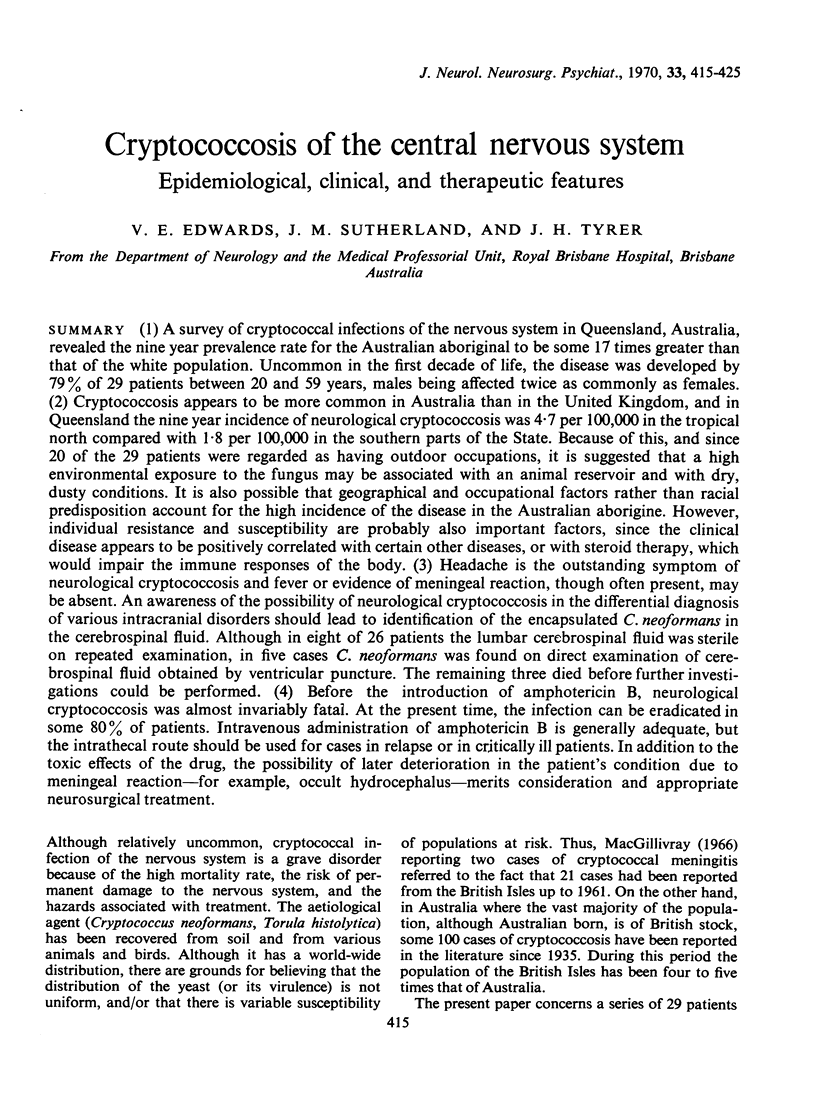
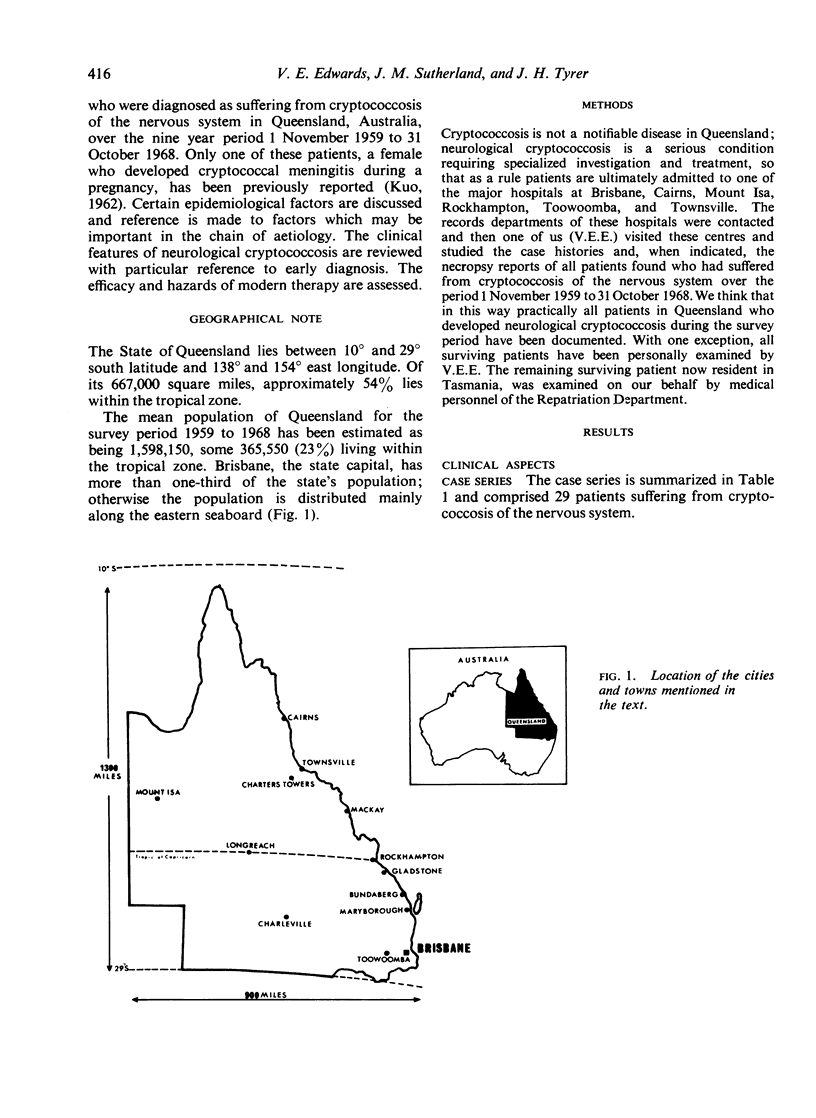

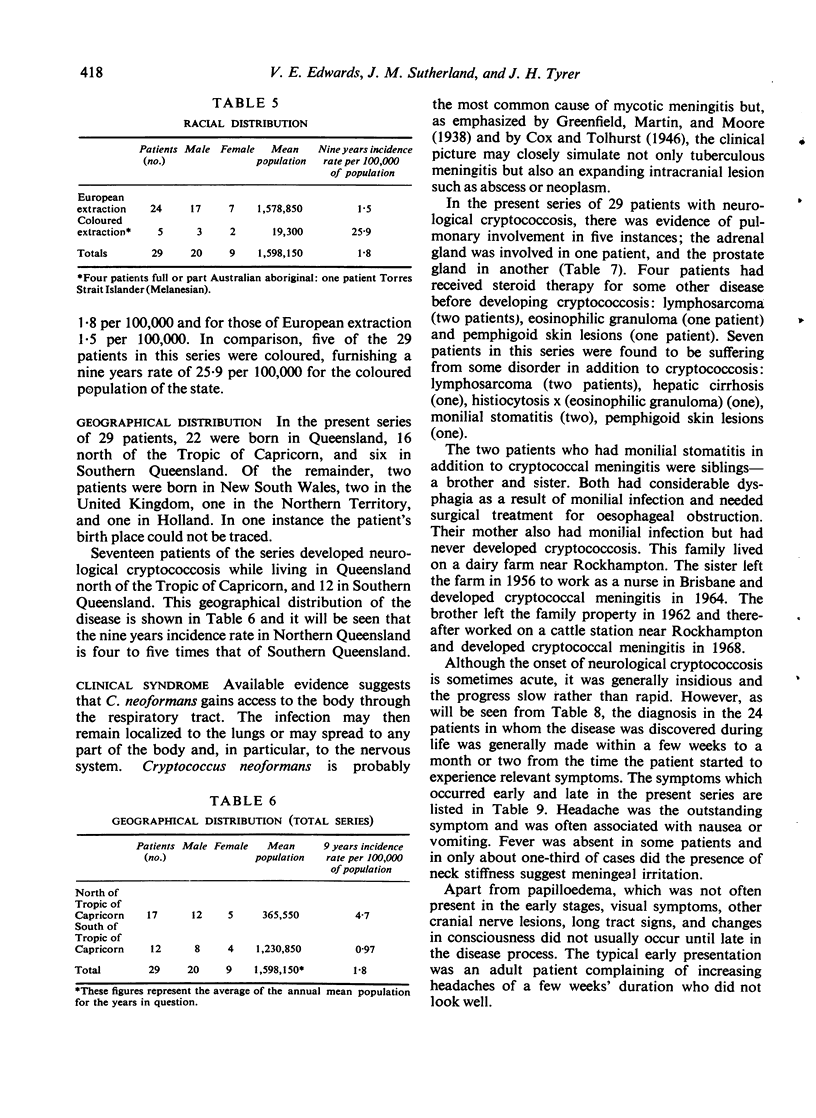
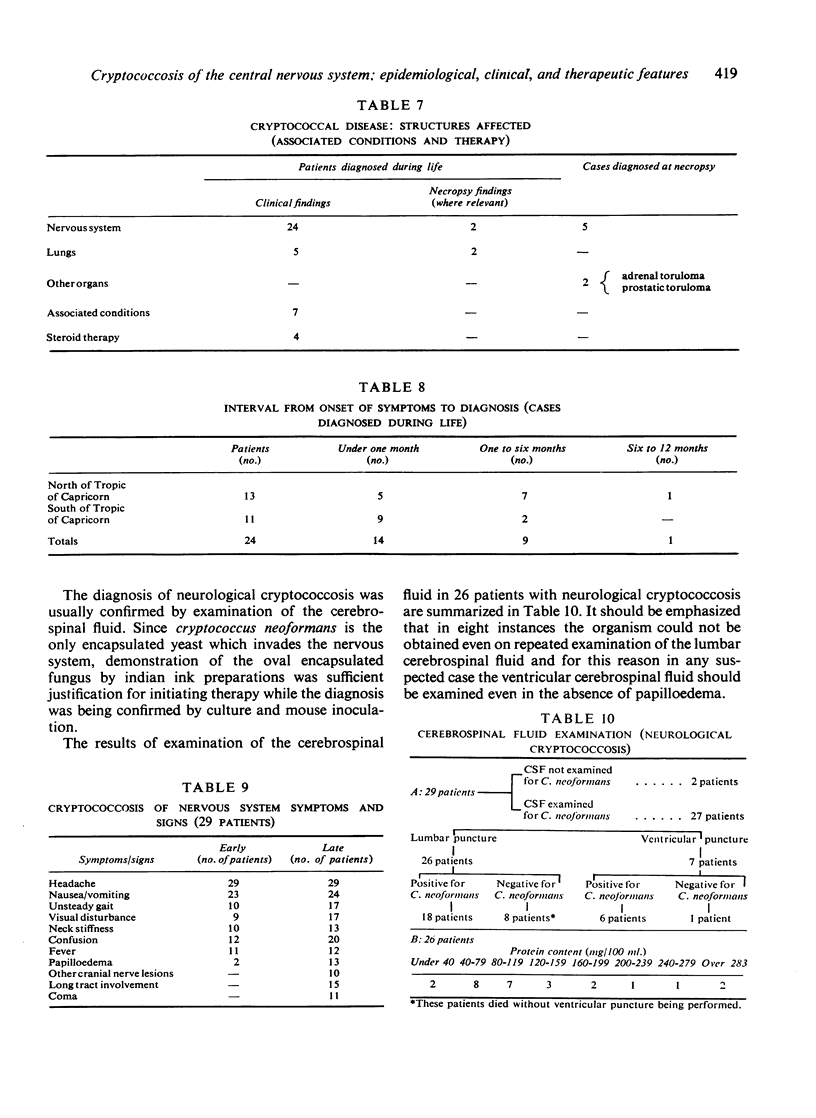
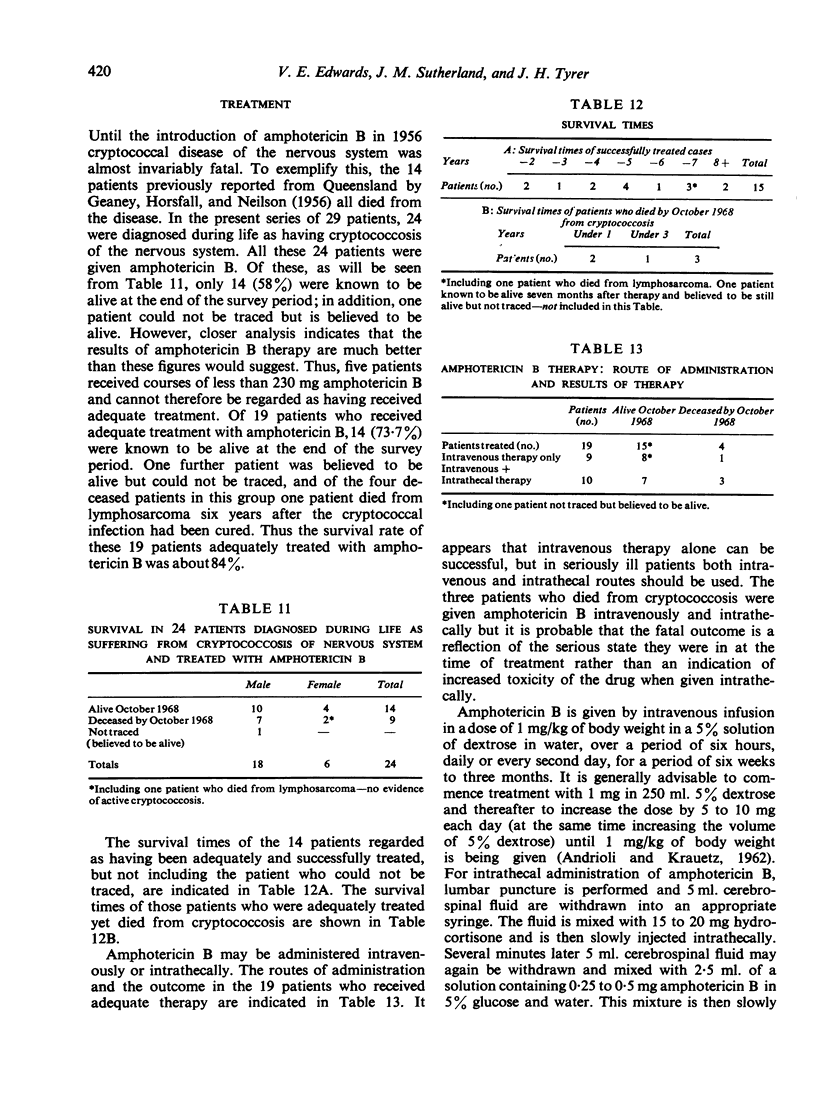
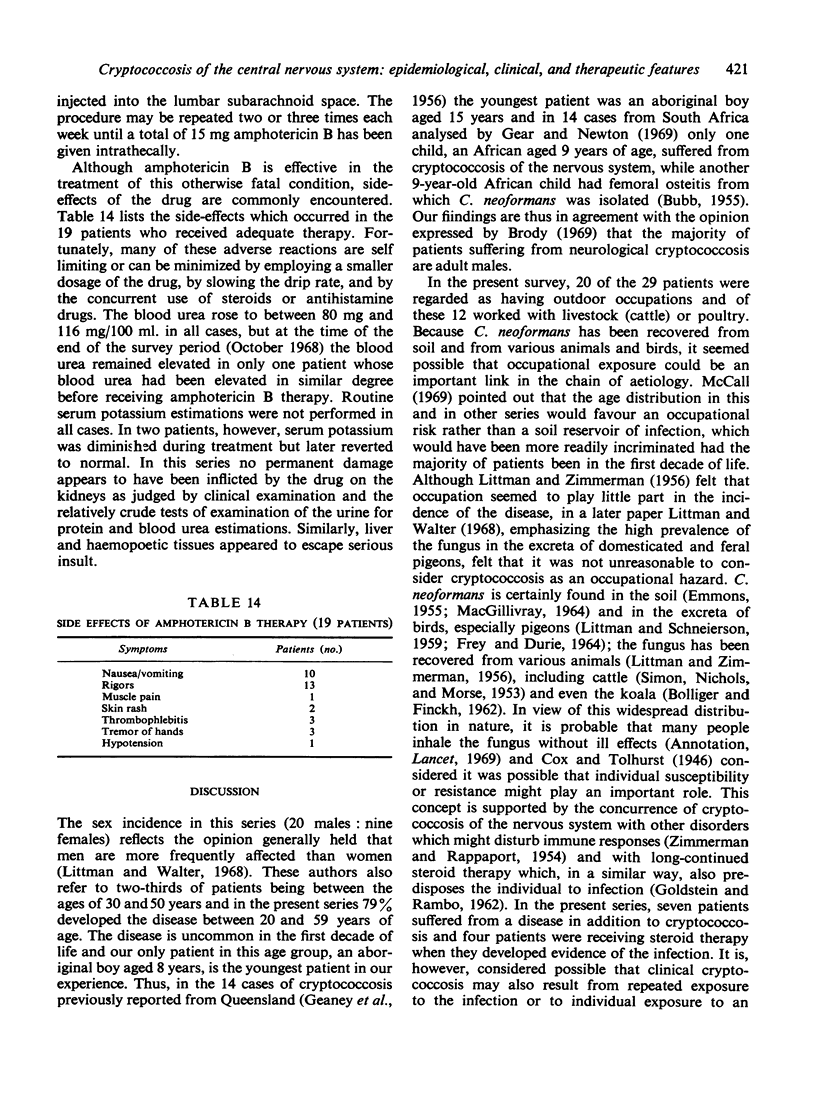


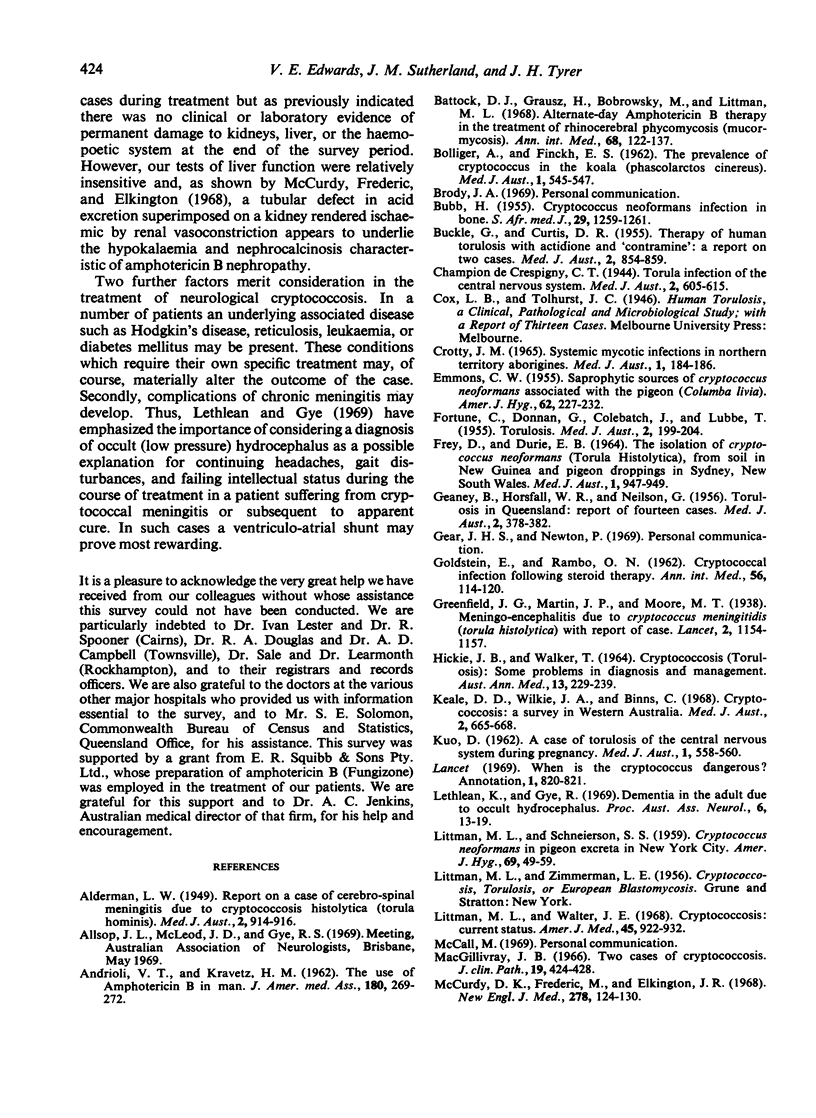

Selected References
These references are in PubMed. This may not be the complete list of references from this article.
- ALDERMAN L. W. Report on a case of cerebrospinal meningitis due to Cryptococcus histolytica. Med J Aust. 1949 Dec 24;2(26):914–916. [PubMed] [Google Scholar]
- ANDRIOLE V. T., KRAVETZ H. M. The use of amphotericin B in man. JAMA. 1962 Apr 28;180:269–272. doi: 10.1001/jama.1962.03050170001001. [DOI] [PubMed] [Google Scholar]
- BOLLIGER A., FINCKH E. S. The prevalence of cryptococcosis in the koala (Phascolarctos cinereus). Med J Aust. 1962 Apr 14;49(1):545–547. [PubMed] [Google Scholar]
- BUBB H. Cryptococcus neoformans infection in bone. S Afr Med J. 1955 Dec 31;29(53):1259–1261. [PubMed] [Google Scholar]
- BUCKLE G., CURTIS D. R. Therapy of human torulosis with actidione and contramine: a report on two cases. Med J Aust. 1955 Nov 19;42(21):854–859. [PubMed] [Google Scholar]
- Battock D. J., Grausz H., Bobrowsky M., Littman M. L. Alternate-day amphotericin B therapy in the treatment of rhinocerebral phycomycosis (mucormycosis). Ann Intern Med. 1968 Jan;68(1):122–137. doi: 10.7326/0003-4819-68-1-122. [DOI] [PubMed] [Google Scholar]
- CROTTY J. M. SYSTEMIC MYCOTIC INFECTIONS IN NORTHERN TERRITORY ABORIGINES. Med J Aust. 1965 Feb 6;1(6):184–186. doi: 10.5694/j.1326-5377.1965.tb71529.x. [DOI] [PubMed] [Google Scholar]
- EMMONS C. W. Saprophytic sources of Cryptococcus neoformans associated with the pigeon (Columba livia). Am J Hyg. 1955 Nov;62(3):227–232. doi: 10.1093/oxfordjournals.aje.a119775. [DOI] [PubMed] [Google Scholar]
- FORTUNE C., DONNAN G., COLEBATCH J., LUBBE T. Torulosis. Med J Aust. 1955 Aug 6;42(6):199–204. [PubMed] [Google Scholar]
- FREY D., DURIE E. B. THE ISOLATION OF CRYPTOCOCCUS NEOFORMANS (TORULA HISTOLYTICA) FROM SOIL IN NEW GUINEA AND PIGEON DROPPINGS IN SYDNEY, NEW SOUTH WALES. Med J Aust. 1964 Jun 20;1:947–949. [PubMed] [Google Scholar]
- GEANEY B., HORSFALL W. R., NEILSON G. Torulosis in Queensland: report of fourteen cases. Med J Aust. 1956 Sep 8;43(10):378–382. doi: 10.5694/j.1326-5377.1956.tb56771.x. [DOI] [PubMed] [Google Scholar]
- GOLDSTEIN E., RAMBO O. N. Cryptococcal infection following steroid therapy. Ann Intern Med. 1962 Jan;56:114–120. doi: 10.7326/0003-4819-56-1-114. [DOI] [PubMed] [Google Scholar]
- HICKIE J. B., WALKER T. CRYTOCOCCOSIS (TORULOSIS): SOME PROBLEMS IN DIAGNOSIS AND MANAGEMENT. Australas Ann Med. 1964 Aug;13:229–239. doi: 10.1111/imj.1964.13.3.229. [DOI] [PubMed] [Google Scholar]
- KUO D. A case of torulosis of the central nervous system during pregnancy. Med J Aust. 1962 Apr 14;49(1):558–560. doi: 10.5694/j.1326-5377.1962.tb26119.x. [DOI] [PubMed] [Google Scholar]
- LITTMAN M. L., SCHNEIERSON S. S. Cryptococcus neoformans in pigeon excreta in New York City. Am J Hyg. 1959 Jan;69(1):49–59. doi: 10.1093/oxfordjournals.aje.a119980. [DOI] [PubMed] [Google Scholar]
- Lethlean K., Gye R. Dementia in the adult due to occult hydrocephalus. Proc Aust Assoc Neurol. 1969;6:13–19. [PubMed] [Google Scholar]
- Littman M. L., Walter J. E. Cryptococcosis: current status. Am J Med. 1968 Dec;45(6):922–932. doi: 10.1016/0002-9343(68)90190-3. [DOI] [PubMed] [Google Scholar]
- MUCHMORE H. G., RHOADES E. R., NIX G. E., FELTON F. G., CARPENTER R. E. Occurrence of Cryptococcus neoformans in the environment of three geographically associated cases of cryptoccal meningitis. N Engl J Med. 1963 May 16;268:1112–1114. doi: 10.1056/NEJM196305162682005. [DOI] [PubMed] [Google Scholar]
- MacGillivray J. B. Two cases of cryptococcosis. J Clin Pathol. 1966 Sep;19(5):424–428. doi: 10.1136/jcp.19.5.424. [DOI] [PMC free article] [PubMed] [Google Scholar]
- McCurdy D. K., Frederic M., Elkinton J. R. Renal tubular acidosis due to amphotericin B. N Engl J Med. 1968 Jan 18;278(3):124–130. doi: 10.1056/NEJM196801182780302. [DOI] [PubMed] [Google Scholar]
- Ommaya A. K. Subcutaneous reservoir and pump for sterile access to ventricular cerebrospinal fluid. Lancet. 1963 Nov 9;2(7315):983–984. doi: 10.1016/s0140-6736(63)90681-0. [DOI] [PubMed] [Google Scholar]
- RUBIN H., FURCOLOW M. L. Promising results in cryptococcal meningitis. Neurology. 1958 Aug;8(8):590–595. doi: 10.1212/wnl.8.8.590. [DOI] [PubMed] [Google Scholar]
- SIMON J., NICHOLS R. E., MORSE E. V. An outbreak of bovine cryptococcosis. J Am Vet Med Assoc. 1953 Jan;122(910):31–35. [PubMed] [Google Scholar]
- SPICKARD A., BUTLER W. T., ANDRIOLE V., UTZ J. P. The improved prognosis of cryptococcal meningitis with amphotericin B therapy. Ann Intern Med. 1963 Jan;58:66–83. doi: 10.7326/0003-4819-58-1-66. [DOI] [PubMed] [Google Scholar]
- Tynes B., Mason K. N., Jennings A. E., Bennett J. E. Variant forms of pulmonary cryptococcosis. Ann Intern Med. 1968 Dec;69(6):1117–1125. doi: 10.7326/0003-4819-69-6-1117. [DOI] [PubMed] [Google Scholar]
- WILSON L. L. Cryptococcosis (torulosis) a report of nine cases. Australas Ann Med. 1958 Nov;7(4):276–285. doi: 10.1111/imj.1958.7.4.276. [DOI] [PubMed] [Google Scholar]
- Warr W., Bates J. H., Stone A. The spectrum of pulmonary cryptococcosis. Ann Intern Med. 1968 Dec;69(6):1109–1116. doi: 10.7326/0003-4819-69-6-1109. [DOI] [PubMed] [Google Scholar]
- Witorsch P., Williams T. W., Jr, Ommaya A. K., Utz J. P. Intraventricular administration of amphotericin B. Use of subcutaneous reservoir in four patients with mycotic meningitis. JAMA. 1965 Nov 15;194(7):699–702. doi: 10.1001/jama.194.7.699. [DOI] [PubMed] [Google Scholar]
- ZIMMERMAN L. E., RAPPAPORT H. Occurrence of Cryptococcosis in patients with malignant disease of reticuloendothelial system. Am J Clin Pathol. 1954 Sep;24(9):1050–1072. doi: 10.1093/ajcp/24.9.1050. [DOI] [PubMed] [Google Scholar]


